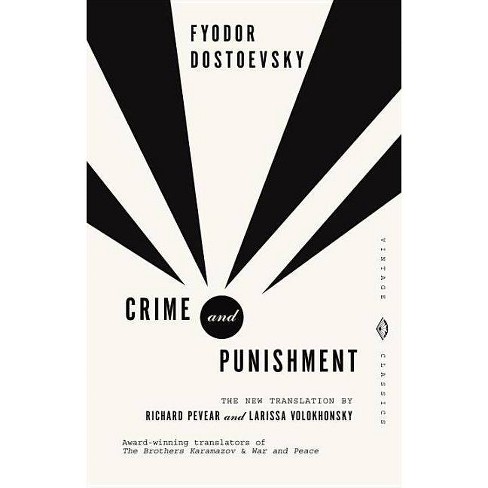By: Fyodor Dostoevsky, trans. Richard Pevear and Larissa Volokhonsky (New York: Vintage Classics, 1993)
Summary:
Written in 1866, Crime and Punishment is a book by Fyodor Dostoevsky that bears no little influence from the author’s actual decade of suffering during his exile in Siberia. In the novel, Raskolnikov, a young and poor ex-student in Saint Petersburg, decides to murder his pawnbroker. Unfortunately, the moneylender’s sister walks in and he too murders her, by splitting her head with an axe. The unlikely protagonist desires to be “a Napoleon”— one so great that laws of convention and morality do not apply—which at times he believes himself to be. Raskolnikov agonizes over three options—killing himself, confessing, and doing nothing—in this story that exists at the intersection of philosophical treatise and psychological thriller, for Dostoevsky deliberately battles against nihilism, rationalism, and utilitarianism while delving (too?) deeply into a disturbed mind.
Themes, Symbols, & Motifs:
- Title. This novel is only very briefly about a crime while the rest centers on a psychological punishment, leading up to a legal one.
- Regret vs. Repentance. Following the murders, Raskolnikov cleans his clothes, hides the stolen materials, and develops a fever. Yet his confession is not until much later.
- Dreams/Hallucinations. Elements of non-reality, such as the horse being whipped, act as foreshadowing and clarification of events.
- Crosses. Sonya gives Raskolnikov a cross to wear during his confession. Both bear a type of cross, Sonya’s being self-sacrificial love for Raskolnikov.
- Imprisonment/Alienation. The former defines or brings about the latter, and vice versa. An excess of intellectualizing and philosophizing can lead to either. Still, as Raskolnikov is increasingly alienated from society, he grows closer to Sonya.
- Raskolnikov’s Name. His name comes from the Russian word for schism or split; and “raskolnik” is “one who splits.” The name connotes a significant theme in the novel—duality.
Discussion Questions:
- Is Raskolnikov—or was he ever—insane?
- Why were the murders committed?
- How does the color yellow frequently function as a symbol?
- As a student, Raskolnikov writes an article that describes two kinds of people. What are these two categories, and in which does Raskolnikov fit?
- Is Raskolnikov a Nietzschean ‘overman’?
- If we assume redemption for Raskolnikov, what role does Sonya play in this?
- Is Raskolnikov a martyr?
- In the Epilogue we can say Raskolnikov finds love, but does he find religion?
- What or who is evil in this novel? What does ‘evil’ mean exactly?
- Is Raskolnikov redeemed through suffering? Biblically, is this possible?
- How does the story of Lazarus literally and metaphorically play into this story? Consider the novel’s final scene.
- Compare and contrast Dostoevsky’s story with Poe’s “The Tell-Tale Heart” or the true crime of Leopold and Loeb.
Drew Trotter
